The Clarkdale Experiment: Mea Culpa
by Loyd Case on May 4, 2010 1:57 PM ESTThe Game is Afoot
I ran a number of games, plus one synthetic benchmark. All tests were run at two different resolutions and detail settings: 1440x900, low graphics settings, and 1920x1080 at fairly high settings. The first, low resolution set of tests represent performance weighted towards the CPU, and are not graphics bound. The second set of tests represent playable resolutions and detail settings, and can be graphics bound in some cases.
· Unigine Heaven (synthetic). The 1440x900 benchmark was run in DX10 mode, the 1920x1080 benchmark run in DX11 mode, with hardware tessellation enabled.
· S.T.A.L.K.E.R.: Call of Pripyat. The lower resolution test was run with the low detail, dynamic presets. The 1080p benchmark was run in DX11 mode, high preset, with hardware tessellation enabled.
· Far Cry 2: Action benchmark. This is one of the included scenarios with the Far Cry 2 benchmark tool, and is pretty CPU intensive – but also represents the game’s more combat-intensive scenes. The low preset was used for the 1440x900 test, the high preset (DX10 enabled) with the higher resolution test.
· Battle Forge. This RTS is CPU intensive, but also implements DX11 graphics in the highest detail modes.
· Tom Clancy’s H.A.W.X. This title is an arcade styleflight sim, with lots of DX10 eye candy.
· DiRT2 (Demo): This rally racing title supports DX11 and DX9, but not DX10.
Let’s take a look at the results.
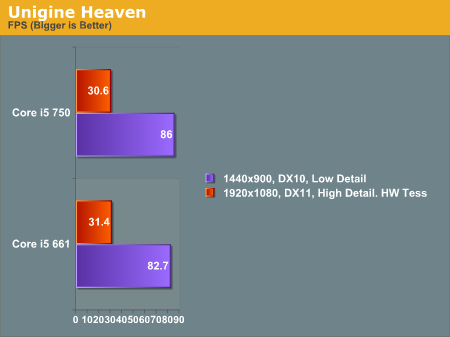
When we keep the resolution and detil levels low (tessellation is off in the low resolution test), the CPU differences are noticeable. Once we dial up the graphics pain, though, the difference is negligible.
Heaven is a synthetic test that pushes certain DX11 features. Let’s see how real games fare.

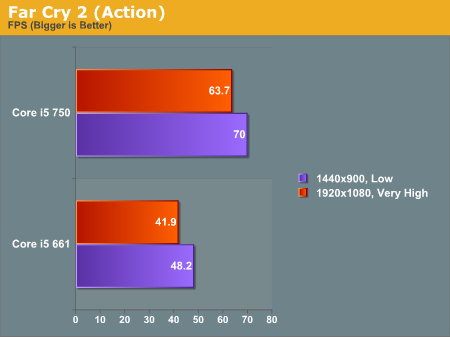
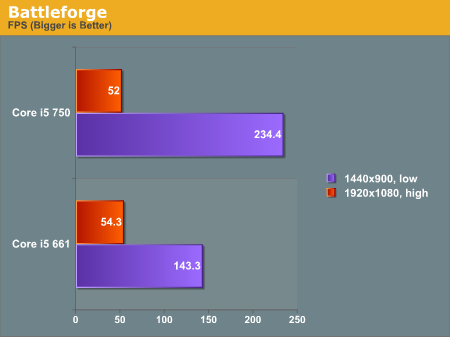
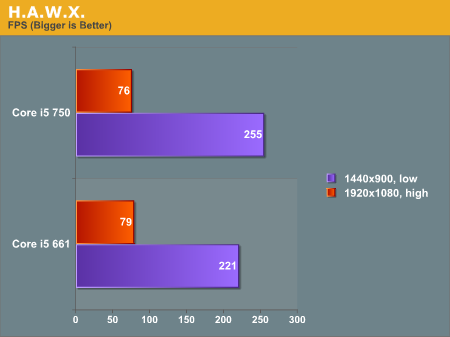
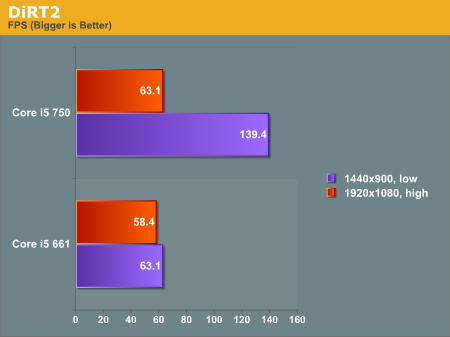
There are some intriguing tidbits in the data. Some of them are a little head-scratching.
Remember, if we run a game at low resolution, with detail levels dialed down, then the game is more likely to be CPU bound than graphics bound. In other words, the CPU impact is exaggerated. If we just look at the low detail results, we see clear wins across the board for Lynnfield. Clearly, if we only ever play games on small displays with crappy visuals, Lynnfield wins out.
The head-scratching part comes in when we dial up the graphics pain. In theory, as you dial up resolution and detail levels, the graphics hardware plays a bigger role, and differences in CPU performance become less noticeable. That’s not true with radical differences in CPU – a slow Celeron compared to a fast Core i7 would run games much more slowly, no matter what GPU is installed. Still, with somewhat similar classes of processors, you’d expect minimal differences.
What we see here, though is a mixed bag. The Far Cry 2 Action scene, for example, still demonstrates a noticeable performance edge for Lynnfield, while we see small, but not insignificant, differences in favor of Clarkdale on Battle Forge and HAWX. Still, the overall edge lies in favor of Lynnfield, with the slower clocked quad core CPU winning in Far Cry 2, DiRT2 and STALKER. These results are pretty much repeatable with multiple runs, too. The numbers vary slightly, but the pattern doesn’t change.










45 Comments
View All Comments
zappb - Wednesday, May 5, 2010 - link
Loyd,I've been a regular reader of anandtech for over 10 years. This is the first time I've registered.
Just to say I enjoyed this review (and the previous Clarkdale experiment) and was perfect for my level. The previous Clarkdale experiment article I printed out and brought it to the bathroom to read in work! Ok I'm sure you didn't want to know that.
Sometimes you just need to throw in a 256 gigabyte SSD, just because you can!,, I would have done this myself.
Good job and keep up the good work.
Peace
mathew7 - Wednesday, May 5, 2010 - link
You say that the power difference is negligible. But I can tell you it's not. I'm not talking about money savings, I'm talking about noise. Especially in a SFF. I bet you did open-bench testing.I have a MicroATX cube with E8400 (soon to be replaced with i5), ASrock G43TwinS, ATI 5850 and Corsair HX450W. The PSU is right above the 5850, with the fan covered by the 2-slot profile of the card.
I play with desktop speakers as I wear glasses and was unable to find a good headphone set.
When I played Mass Effect 2 (I don't recall if it was before or after underclocking the 5850), I noticed after 30min of gameplay a noisier than usual computer. But how I noticed it? Because every time there was saving or loading involved (including level change) I would hear an rpm lowering. The rpm was being lowered less than 1s after save/load triggering and would get high again less than 1s after it finished the action. The CPU has the big heatsink that would not permit such fast reaction. The GFX card fan was not, as I would place my finger to stop it from spinning and no noise change was heard. So the only remaining "stressed" component was the PSU (do NOT tell me that I have a too weak PSU, because I have NEVER had a system that would consume more than 350W at the UPS).
So dismissing the Clarkdale because it's slower and the power difference is not justifiable by savings is not a good reccomandation. If you test SFF components, PUT THEM IN A SFF CASE. The combined effect of restricted airflow and higher power draw could put the PSU in a "crank up the fan" situation. So maybe the 661's power advantage is much better seen(or heard) then 750's performance advantage IN A SFF.
PS: in the system comparison table you wrote "core i7 750".
7Enigma - Wednesday, May 5, 2010 - link
Saw your post and wanted to comment (hopefully you see it):I, like you, wear glasses and headphones were always an annoyance. But with a kid and another on the way the only time I get to play games is at night when said kid is asleep and a booming sub and loud speakers would not be "allowed". So I did a bunch of searching and came up with the highly recommended Seinheiser HD280. I got mine for $80 on a sale and they frequently go on sale at the major e-taliers. Fantastic sound quality and surprisingly comfortable even after extended gaming/listening to music/movies with glasses.
Check them out, and I hope this helps a fellow 4-eye. :)
Finraziel - Friday, May 7, 2010 - link
While you have a point, I think you'd be better off improving your airflow or for instance choosing a case where the PSU draws its air from outside, or just get a better PSU, rather than choosing a slower yet more expensive part just in case your PSU fan might get a bit antsy. I think your example mostly serves to not underestimate the impact of choosing the correct PSU if you want a silent system.Also, don't overlook that the difference in power draw can not possibly be only or even largely from the CPU difference. There's only an 8 watt difference in TDP and while I know TDP does not equate to how much a CPU actually uses, I think it's fair to say that the 750 itself isn't actually consuming over 60 watts more than the 661. Since P55 mainboards don't draw much power either (I have to admit I have no real numbers, but how else would they be able to survive without bigger heatsinks), the biggest difference I would say has to come from the videocard that is allowed to work harder because the 750 can feed it better. So if it really bothers you on a hot day or something, underclock your CPU and videocard and you should get the same effect.
On a sidenote, I agree on the sennheiser :). I also wear glasses and also have one of the sennheiser models that go completely over your ear and with a soft cushion... Unfortunately I don't know the model nr and am not at home, but it's survived for about 10 years now already I guess, including dragging it along to quite a few lanparties. I absolutely love it, investing in good comfortable headphones is definately worth it I'd say.
basket687 - Wednesday, May 5, 2010 - link
Please clarify how you measured power consumption, did you run a game, a stress test, or something else?The difference in power consumption under load is about 65W and this is really more difference than what I would expect between an i5 750 and an i5 661.
If you measured it by running a game the result can be biased towards the Clarkdale because it is slower and thus imposes less load on the GPU.
mathew7 - Thursday, May 6, 2010 - link
You have to remember that he's comparing SYSTEM load. The 661has 87W TDP with GFX while 750 has 95W TDP without GFX. Since the integrated GFX is not used, the difference is even higher. Also, since the MBs are different, they also have different power consumptions.zipzoomflyhigh - Wednesday, May 5, 2010 - link
Why use a cpu with integrated video and a H55 and then drop in a HD5850??Makes no sense whatsoever. Your paying a premium for a cpu with built in graphics for what?
ClagMaster - Wednesday, May 5, 2010 - link
The Clarksdale is really meant for HTPC and Office PC applications. Here the on-die GPU will be used.However for HTPC or Office PC, I believe you would get much better value and good performance with AMD Athlon X2 and 890G motherboard .
I agree I would have preferred a dual core processor without the GPU. Power consumption would be better.
strikeback03 - Thursday, May 6, 2010 - link
If the GPU isn't being used it won't consume power. And given that these are the only dual-core 32nm processors around I imagine they are still the most power-efficient ones around (short of Atom/CULV, which are far less powerful).BernardP - Wednesday, May 5, 2010 - link
Intel could reduce prices to a more competitive level and reach users not interested in its integrated graphics by offering the Clarkdale architecture in a lineup of CPU-only chips.Give us a CPU-only version of the i5-680 @ 3.6 GHz with 4,0 GHz Turbo and I will be glad to add my own graphics card to build a nice all-around machine for multimedia and casual gaming.